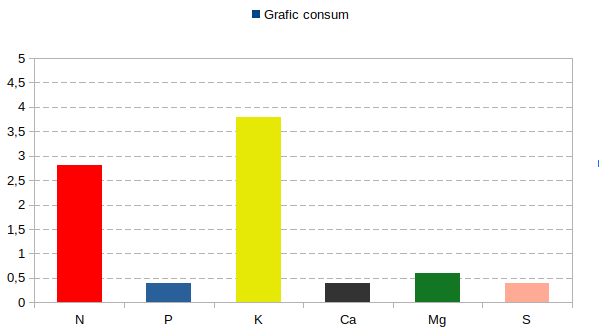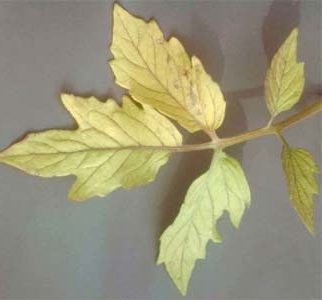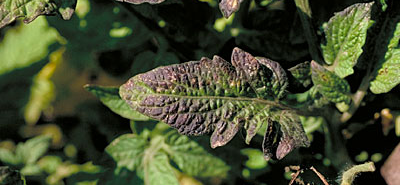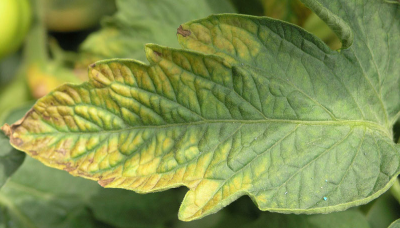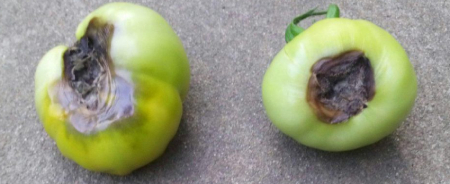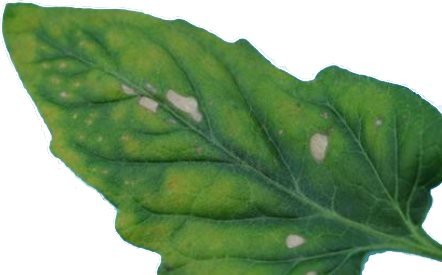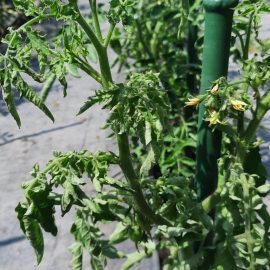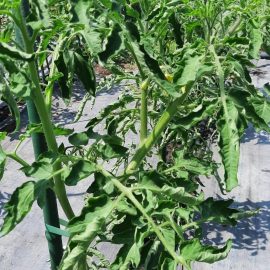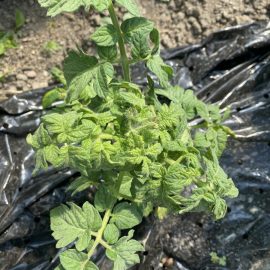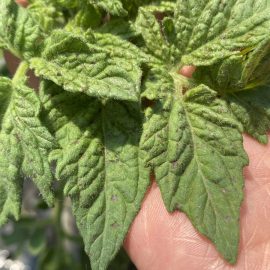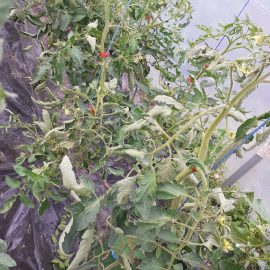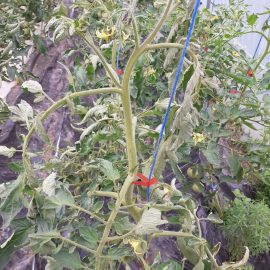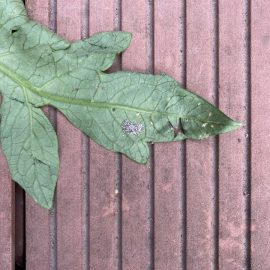Tomatoes – fertilization at different stages of crop development
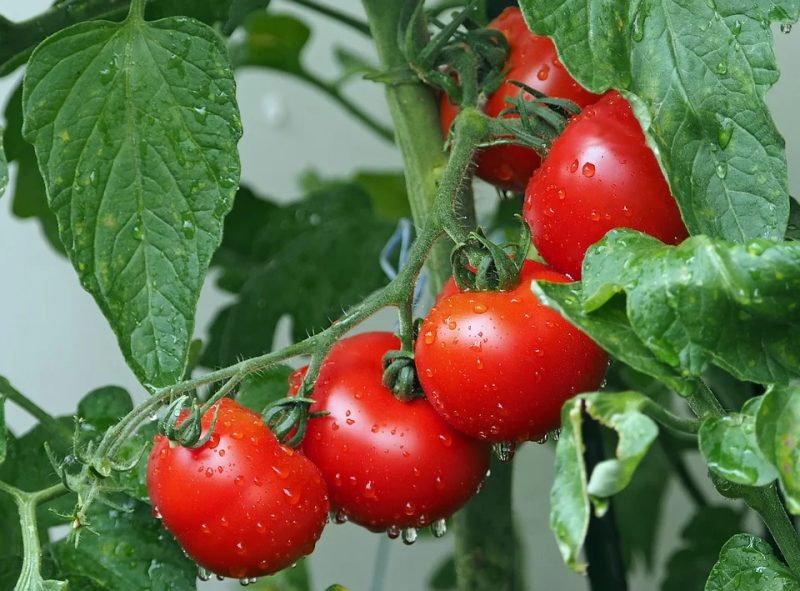
Tomatoes are grown on a large scale for their edible fruits, being a good source of vitamin C, mineral salts, and organic acids. The fruits can be consumed in many ways, either immediately after they have been harvested or used as an ingredient in different dishes. Besides these, the tomato harvest is used for processing, obtaining tomato juice, ketchup, tomato paste, etc.
In their native country, tomatoes are perennials, but in the environmental conditions of some countries with a temperate climate, they behave as annual plants.
Vegetable plants grown in the field or protected areas have a high consumption of nutrients because the production capacity is high. Understanding nutrients and their influence on plant life and crop yields is of great importance.
Tomatoes have periods during vegetation when if they do not have enough nutrients, some processes take place that affect their growth and development. These are called critical phases of nutrition.
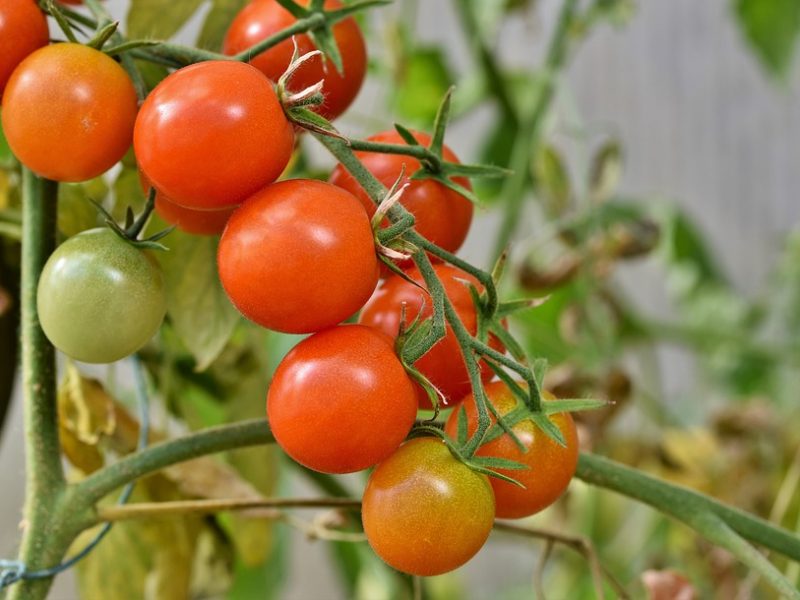
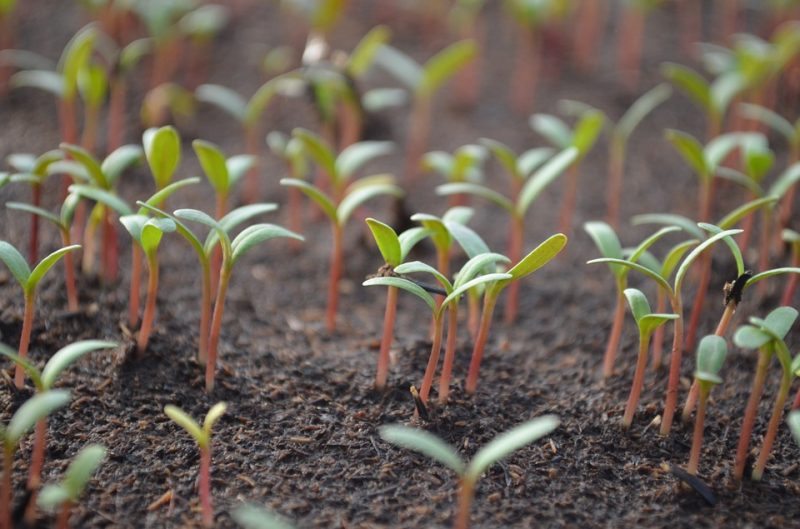
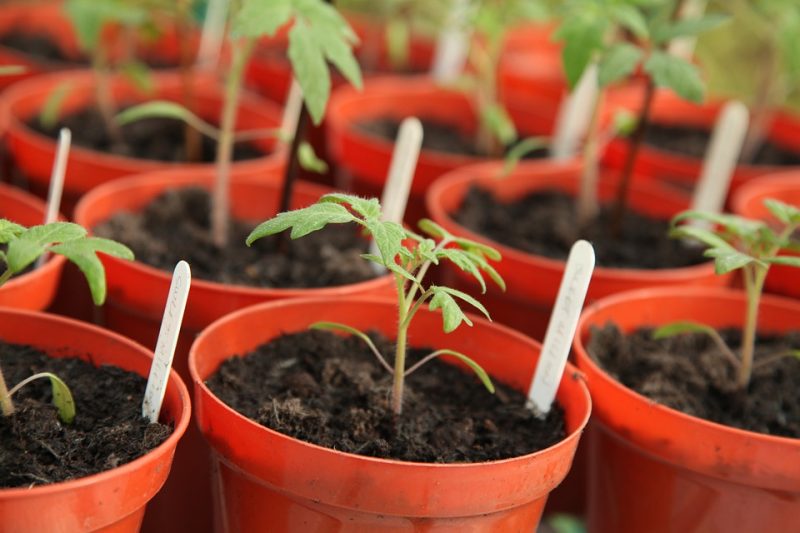
The critical phases of tomato nutrition are:
- when the first flowers appear, to avoid this phenomenon, it is recommended to apply products containing phosphorus;
- when the first fruits begin to ripen, it is recommended to apply phosphorus products for early ripening.
The role of macronutrients in tomato culture
Tomato plant growth and yield are conditioned and influenced by the amount of nitrogen (N) administered and available to the plants.
Nitrogen (N) is one of the most complex and important nutrients, occupying the fourth position after C, O, and H. Use of nitrogen is conditioned during the growing season by several factors, such as soil pH, species, and plant age.
Phosphorus (P) is very important in plant energy transfer, a vital process for plants. This element contributes to the plant’s resistance to frost and drought. Phosphorus (P) is essential for the normal development of the root system, stem, flower formation, and early fruit ripening.
Potassium (K) is one of the essential macronutrients of plants, it indirectly stimulates element uptake in the plant. The plant’s ability to protect itself against diseases, pests and climatic conditions is given by potassium action inside the plant. Potassium not only influences plant resistance but also the quality of the crop.
Another very important macronutrient is calcium (Ca), which is a component of cell walls and membranes. A deficient supply of this element can lead to small, cup-like leaves, and aborted flowers, but there is also a risk of apical tip rot.
Magnesium – it is a very important macronutrient, which acts throughout the entire vegetative growth period, fulfilling several functions such as:
- it is the central component of chlorophyll that is very important in the photosynthesis process;
- it is a carrier of phosphorus in plants;
- it is involved in the process of cell division.
Sulfur – it is a very important nutrient in plant production because it fulfills many functions, such as:
- it acts in the process of chlorophyll formation;
- plays an important role in proteins, vitamins, and enzyme formation;
- it helps the plants during the dormancy period.
The consumption of macronutrients in tomato crop
How do deficiencies in macronutrients manifest in tomato crops
Nitrogen deficiency (N)
- mature leaves turn pale green, and once the degree of deficiency increases, the leaves become chlorotic (uniformly yellow);
- the branching process also decreases, resulting in short-sized plants;
- the percentage of the flowers decreases.
Measures to correct the deficiency
- periodic fertilization with products containing N, in economical doses.
Recommended products
-
You can find products on a different store
Change Store -
You can find products on a different store
Change Store -
You can find products on a different store
Change Store -
You can find products on a different store
Change Store -
You can find products on a different store
Change Store -
You can find products on a different store
Change Store -
You can find products on a different store
Change Store -
You can find products on a different store
Change Store -
You can find products on a different store
Change Store -
You can find products on a different store
Change Store -
You can find products on a different store
Change Store -
You can find products on a different store
Change Store -
You can find products on a different store
Change Store -
You can find products on a different store
Change Store -
You can find products on a different store
Change Store -
You can find products on a different store
Change Store -
You can find products on a different store
Change Store -
You can find products on a different store
Change Store -
You can find products on a different store
Change Store -
You can find products on a different store
Change Store -
You can find products on a different store
Change Store -
You can find products on a different store
Change Store -
You can find products on a different store
Change Store -
You can find products on a different store
Change Store
Phosphorus (P) deficiency
- Phosphorus deficiency develops acropetally (from the base towards the top);
- the root system develops with difficulty;
- on the leaves, the symptoms appear at the base and then spread to the tip;
- the leaves darken in color, then take on a violet hue.
Measures to correct the deficiency
- by administering and incorporating fertilizers containing P;
- by using liquid fertilizers containing P.
Recommended products
-
You can find products on a different store
Change Store -
You can find products on a different store
Change Store -
You can find products on a different store
Change Store -
You can find products on a different store
Change Store -
You can find products on a different store
Change Store -
You can find products on a different store
Change Store -
You can find products on a different store
Change Store -
You can find products on a different store
Change Store -
You can find products on a different store
Change Store -
You can find products on a different store
Change Store -
You can find products on a different store
Change Store -
You can find products on a different store
Change Store -
You can find products on a different store
Change Store -
You can find products on a different store
Change Store -
You can find products on a different store
Change Store -
You can find products on a different store
Change Store -
You can find products on a different store
Change Store -
You can find products on a different store
Change Store -
You can find products on a different store
Change Store -
You can find products on a different store
Change Store -
You can find products on a different store
Change Store -
You can find products on a different store
Change Store -
You can find products on a different store
Change Store -
You can find products on a different store
Change Store
Potassium deficiency (K)
- K deficiency appears on basal leaves and increases towards the tips;
- the elasticity of the stems is low, being prone to break;
- loss of turgidity causing leaves to look wilted;
- early growth leads to restricted respiration, meaning higher plant water consumption.
Measures to correct the deficiency
- fractionation of K doses;
- avoiding waterlogging through drainage works;
- by using liquid fertilizers.
Recommended products
-
You can find products on a different store
Change Store -
You can find products on a different store
Change Store -
You can find products on a different store
Change Store -
You can find products on a different store
Change Store -
You can find products on a different store
Change Store -
You can find products on a different store
Change Store -
You can find products on a different store
Change Store -
You can find products on a different store
Change Store -
You can find products on a different store
Change Store -
You can find products on a different store
Change Store -
You can find products on a different store
Change Store -
You can find products on a different store
Change Store -
You can find products on a different store
Change Store -
You can find products on a different store
Change Store -
You can find products on a different store
Change Store -
You can find products on a different store
Change Store -
You can find products on a different store
Change Store -
You can find products on a different store
Change Store -
You can find products on a different store
Change Store -
You can find products on a different store
Change Store -
You can find products on a different store
Change Store -
You can find products on a different store
Change Store -
You can find products on a different store
Change Store -
You can find products on a different store
Change Store
Calcium (Ca) deficiency
- calcium deficiency has a direct influence on the plants;
- it is more often encountered in vegetables and flowers in greenhouse conditions;
- the terminal buds degenerate;
- the young tissues from the top of the plants collapse;
- blackish brown or grayish rot appears (blossom end rot).
Measures to correct the deficiency
- specific works to reduce the soil acidity;
- avoid excessive fertilization with K, N, and Mg as much as possible;
- use liquid or solid fertilizers containing Ca.
Recommended products
-
You can find products on a different store
Change Store -
You can find products on a different store
Change Store -
You can find products on a different store
Change Store -
You can find products on a different store
Change Store -
You can find products on a different store
Change Store -
You can find products on a different store
Change Store -
You can find products on a different store
Change Store -
You can find products on a different store
Change Store -
You can find products on a different store
Change Store -
You can find products on a different store
Change Store -
You can find products on a different store
Change Store -
You can find products on a different store
Change Store -
You can find products on a different store
Change Store -
You can find products on a different store
Change Store -
You can find products on a different store
Change Store -
You can find products on a different store
Change Store -
You can find products on a different store
Change Store -
You can find products on a different store
Change Store -
You can find products on a different store
Change Store -
You can find products on a different store
Change Store -
You can find products on a different store
Change Store -
You can find products on a different store
Change Store -
You can find products on a different store
Change Store -
You can find products on a different store
Change Store
Magnesium (Mg) deficiency
- in the initial phase it manifests itself on the basal leaves, then it spreads towards the top leaves;
- chlorosis appears on the leaves, in tomatoes, it starts from the center of the leaf and spreads to the edges.
Measures to correct the deficiency
- by applying fertilizers with Mg.
Recommended products
-
You can find products on a different store
Change Store -
You can find products on a different store
Change Store -
You can find products on a different store
Change Store -
You can find products on a different store
Change Store -
You can find products on a different store
Change Store -
You can find products on a different store
Change Store -
You can find products on a different store
Change Store -
You can find products on a different store
Change Store -
You can find products on a different store
Change Store -
You can find products on a different store
Change Store -
You can find products on a different store
Change Store -
You can find products on a different store
Change Store -
You can find products on a different store
Change Store -
You can find products on a different store
Change Store -
You can find products on a different store
Change Store -
You can find products on a different store
Change Store -
You can find products on a different store
Change Store -
You can find products on a different store
Change Store -
You can find products on a different store
Change Store -
You can find products on a different store
Change Store -
You can find products on a different store
Change Store -
You can find products on a different store
Change Store -
You can find products on a different store
Change Store -
You can find products on a different store
Change Store
Sulfur (S) deficiency
- Sulfur deficiency generally occurs in very humid areas;
- Sulfur deficiency presents symptoms similar to nitrogen (N) deficiency;
- the symptoms appear at the beginning on the growth tips, then on the young leaves;
- photosynthesis is reduced;
- the vegetative growth is reduced.
Measures to correct the deficiency
- administration of solid or liquid fertilizers with a high content of S.
Recommended products
-
You can find products on a different store
Change Store -
You can find products on a different store
Change Store -
You can find products on a different store
Change Store -
You can find products on a different store
Change Store -
You can find products on a different store
Change Store -
You can find products on a different store
Change Store -
You can find products on a different store
Change Store -
You can find products on a different store
Change Store -
You can find products on a different store
Change Store -
You can find products on a different store
Change Store -
You can find products on a different store
Change Store -
You can find products on a different store
Change Store -
You can find products on a different store
Change Store -
You can find products on a different store
Change Store -
You can find products on a different store
Change Store -
You can find products on a different store
Change Store -
You can find products on a different store
Change Store -
You can find products on a different store
Change Store -
You can find products on a different store
Change Store -
You can find products on a different store
Change Store -
You can find products on a different store
Change Store -
You can find products on a different store
Change Store -
You can find products on a different store
Change Store -
You can find products on a different store
Change Store














































































































































































































































































































































































































































